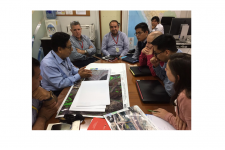In recent years, the several space agencies have adopted open data policies that allow practitioners to access their satellite imagery for subsequent processing. With the support of its Regional Support Offices and other Centres of Excellence, UN-SPIDER has developed several Recommended Practices to process satellite imagery to generate specific types of maps.
The space and geospatial communities have also developed products and services with the aim of contributing to disaster risk reduction, preparedness, response, and recovery efforts; as well as to address challenges related to climate change. Such contributions are ultimately expected to contribute to efforts worldwide to achieve the sustainable development goals, the targets of the Paris Climate Change agreement and those included in the Sendai Framework for Disaster Risk Reduction 2015-2030.
UN-SPIDER is joining efforts with its network of Regional Support Offices and other partners to present examples of practical uses of space-based products including the maps elaborated with the UN-SPIDER Recommended Practices and those products and services implemented by the Space community.
Each example provides an overview of the practical use of a product or a service in the framework of disaster risk management, as well as in standard operating procedures employed in response and recovery efforts.
If you have questions or wish to share your own experience regarding these Practical Uses, please contact us.

